#alfonso iii
Photo
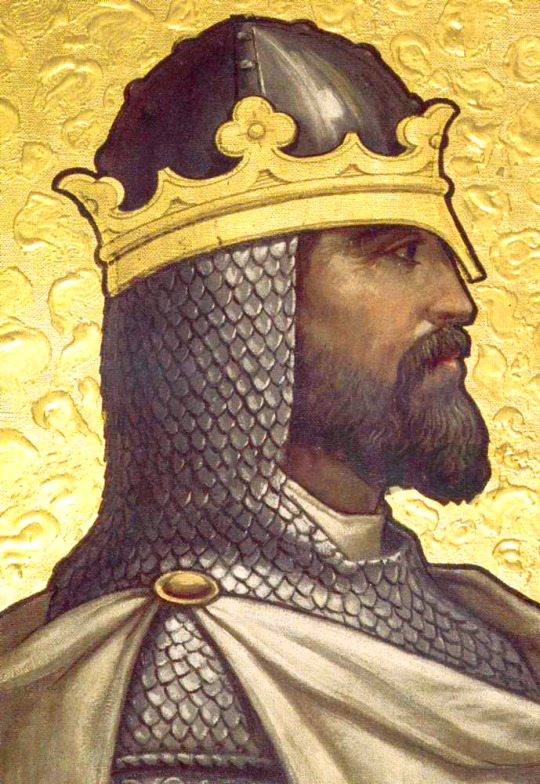

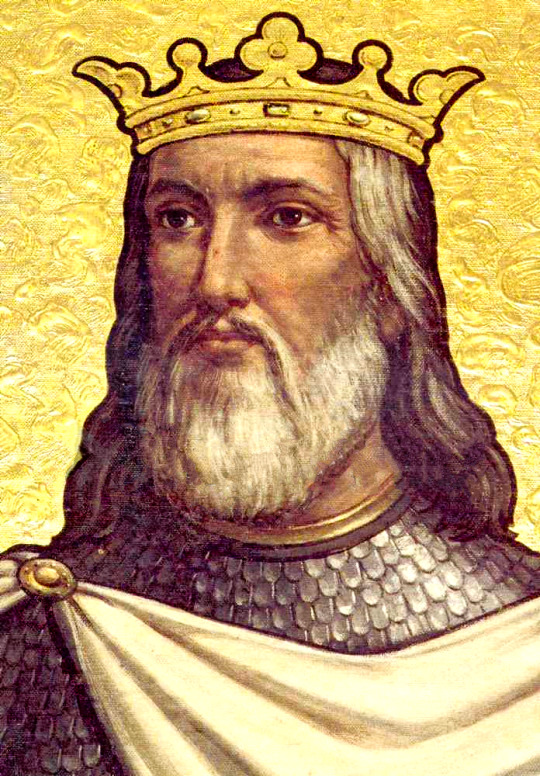






Portuguese monarchs: The House of Burgundy (Afonso Henriques, Sancho I, Afonso II, Sancho II, Afonso III, Denis I, Afonso IV, Peter I and Ferdinand I).
#reis de portugal#kings of portugal#reino de portugal#Alfonso henriquez#sancho i#alfonso ii#sancho ii#alfonso iii#dinis i#alfonso iv#pedro i#fernando i#house of burgundy#casa de borgonha#list of monarchs
12 notes
·
View notes
Text
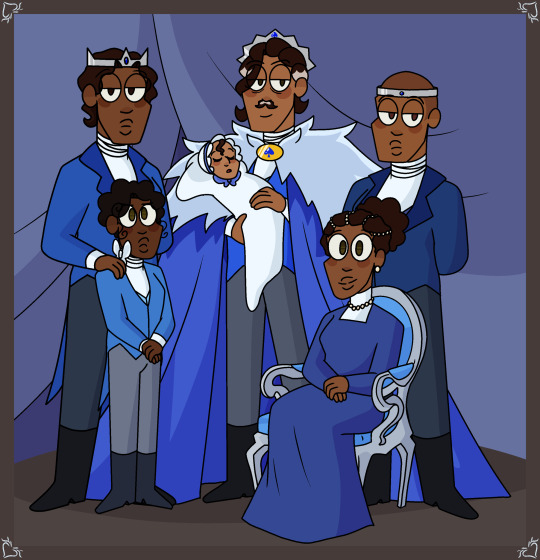
AU where all Alfonso’s kids lived and Dylan had brothers and a sister
#my art#cards#spades#Alfonso espadas iii#Alfonso espadas iv#Alfie espadas#Michael espadas#Joanna espadas#Henry espadas#Dylan espadas#king of spades#Jack of spades#ace of spades#prince of spades#princes of spades#princess of spades#au#little brother dylan au#lbd au#i actually love this au#dylan doesn’t actually gain brothers he just has multiple dads#also Alfie (the oldest) is just goofy but he gotta look serious as heir#Alfonso espadas
71 notes
·
View notes
Text
Leonor to Catherine of Aragon. House of Borbón to House of Trastámara.
#credits to the rightful owners#house of borbón#House of Trastámara#spanish royal family#princess leonor#king felipe vi#Juan carlos I#infante juan count of Barcelona#king Alfonso xiii#king alfonso xii#queen isabella ii of spain#king Ferdinand VII#Charles IV of Spain#Charles III of Spain#Philip V of Spain#Luis grand dauphin#Maria Theresa of Spain#Philip IV of Spain#Philip III of Spain#Philip II of Spain#Charles V of Spain#juana i of castile#catherine of aragon
7 notes
·
View notes
Text
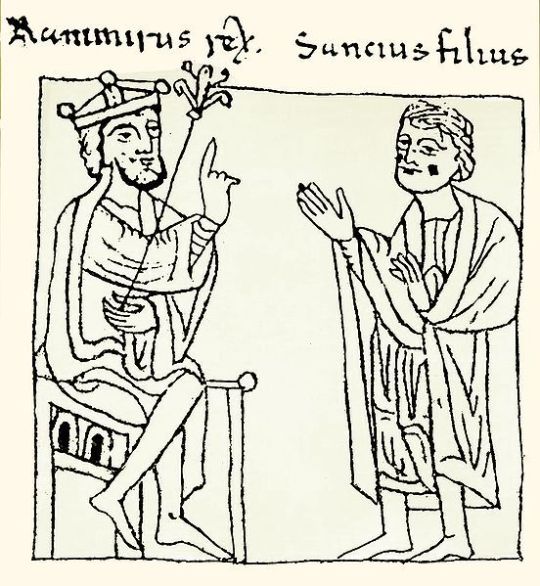



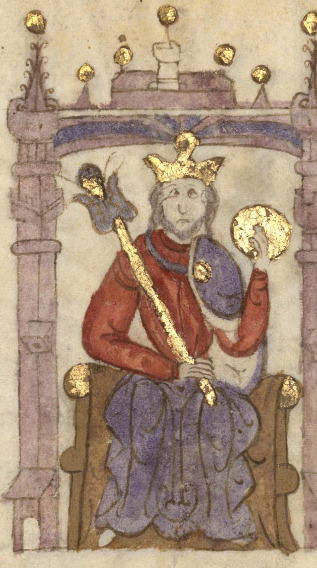

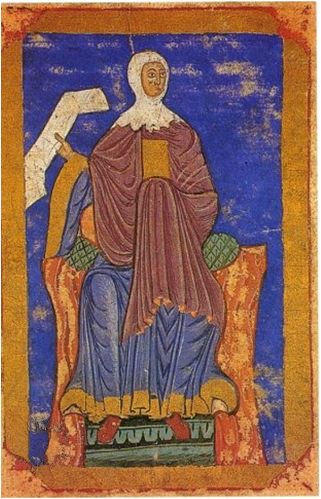

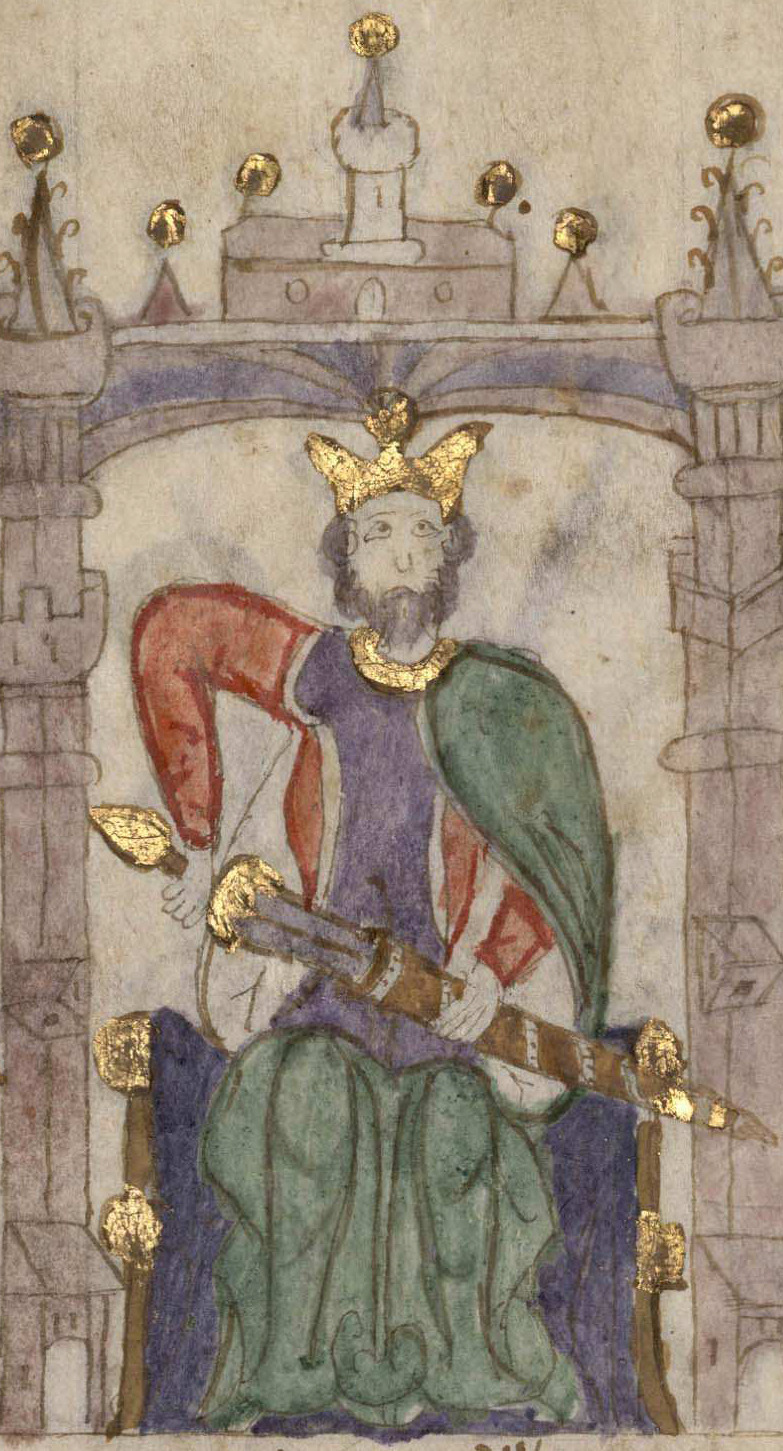

The Bastard Kings and their families
This is series of posts are complementary to this historical parallels post from the JON SNOW FORTNIGHT EVENT, and it's purpouse to discover the lives of medieval bastard kings, and the following posts are meant to collect portraits of those kings and their close relatives.
In many cases it's difficult to find contemporary art of their period, so some of the portrayals are subsequent.
1) Ramiro I of Aragon (1006/7- 1063), son of Sancho III of Pamplona and Sancha de Aybar; with his son Sancho I of Aragon & V of Pamplona (1043-1094)
2) His wife, Ermesinda of Foix (1015 - 1049), mother of Sancho I of Aragon. Daughter of Bernard Roger de Foix and his wife Garsenda de Bigorra; and Sancha of Aragon (1045-1097), daughter of Ramiro I and Ermesinda
3) His father, Sancho III of Pamplona (992/96-1035), son of García II of Pamplona and Jimena Fernández
4) His brother, García III of Pamplona (1012-1054), son of Sancho III of Pamplona and his wife Muniadona of Castile
5) His nephew, Sancho IV of Pamplona (1039- 1076), son of García III of Pamplona and his wife Placencia of Normandy
6) His brother, Ferdinand I of Leon (1016- 1065), son of Sancho III of Pamplona and his wife Muniadona of Castile
7) His niece, Urraca of Zamora (1033-1101), daughter of Ferdinand I of Leon and Sancha of Leon
8) His niece, Elvira of Toro (1038-1099), daughter of Ferdinand I of Leon and Sancha of Leon
9) Sancho II of Castile (1038/1039-1072), son of Ferdinand I of Leon and Sancha of Leon
10) Alfonso VI of Leon (1040/1041-1109), son of Ferdinand I of Leon and Sancha of Leon
#jonsnowfortnightevent#jonsnowfortnightevent2023#asoiaf#a song of ice and fire#day 10#echoes of the past#historical parallels#medieval bastard kings#ramiro i of aragon#sancho i of aragon#sancha of aragon#ermesinda of foix#sancho iii of pamplona#garcía iii of pamplona#sancho iv of pamplona#ferdinand i of leon#urraca of zamora#elvira of toro#sancho ii of castile#alfonso vi of leon#bastard kings and their families#canonjonsnow
26 notes
·
View notes
Text
Santa Catalina disputando con un filósofo ante el tribunal del Emperador Majencio (Relieve, siglo XIII)
Se trata de un relieve fechado entre los años 1252 y 1286 (siglo XIII), realizado en mármol blanco, perteneciente a la colección Ars Casacuberta Marsans. Formó parte de la exposición temporal “Alfonso X, el legado de un rey precursor”, que tuvo lugar en el Museo de Santa Cruz, de Toledo, en 2022. Se cumplían los 800 años del nacimiento de este rey que nació el día 23 de noviembre de 1221,…
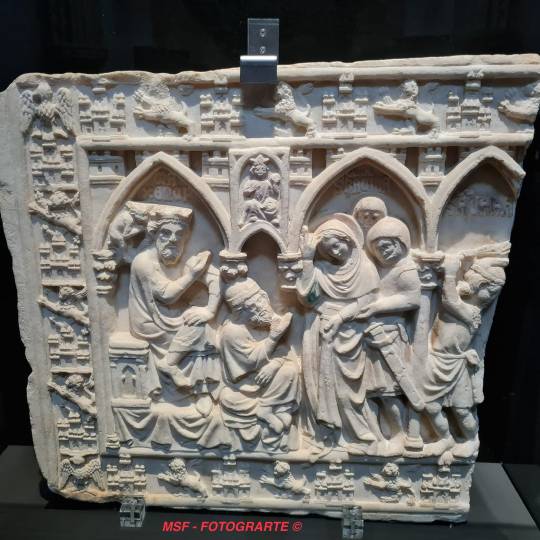
View On WordPress
#Alfonso X el Sabio#Barcelona#Beatriz de Suabia#Colección Ars Casacuberta Marsans#Edad Media#España#Exposiciones Temporales#Fernando III el Santo#Infanta Berenguela de Castilla (monja en Las Huelgas)#Monasterio de las Huelgas (Burgos)#Museo de Santa Cruz#Relieve#Siglo XIII#Toledo
4 notes
·
View notes
Text
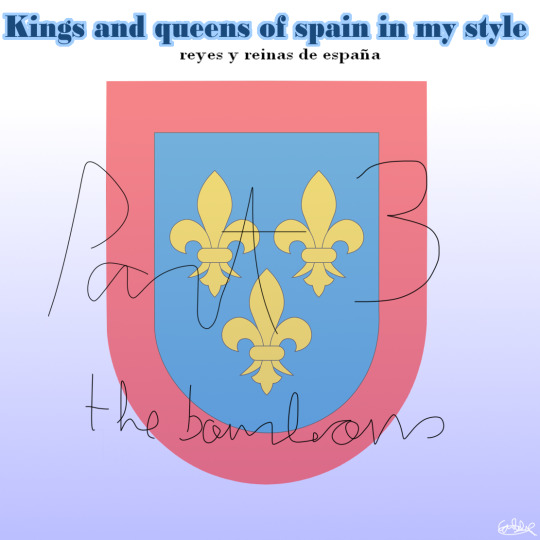
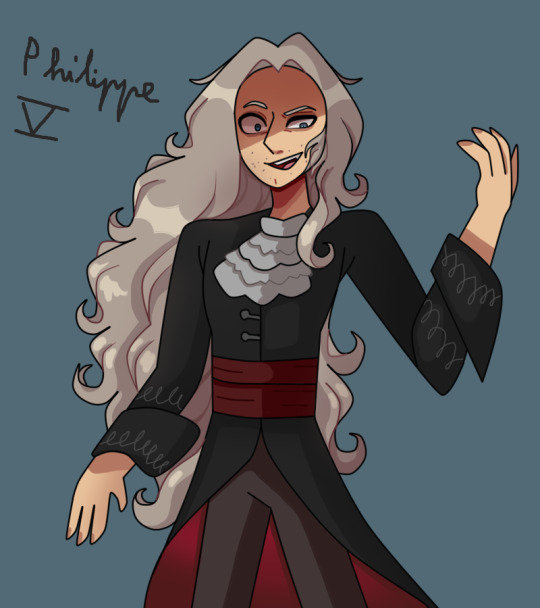

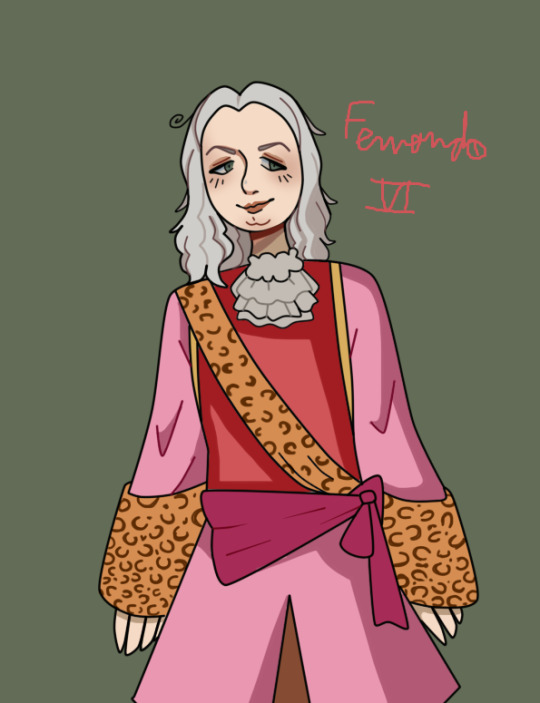




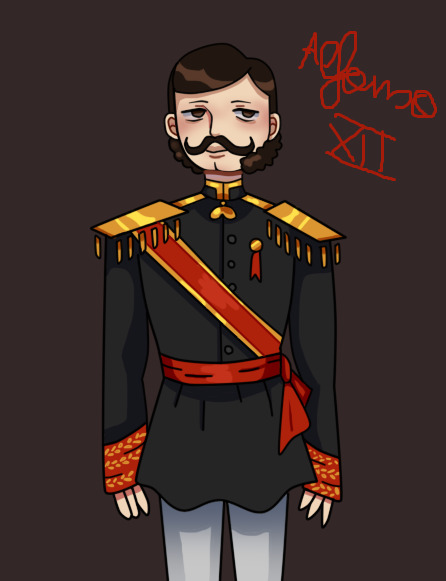
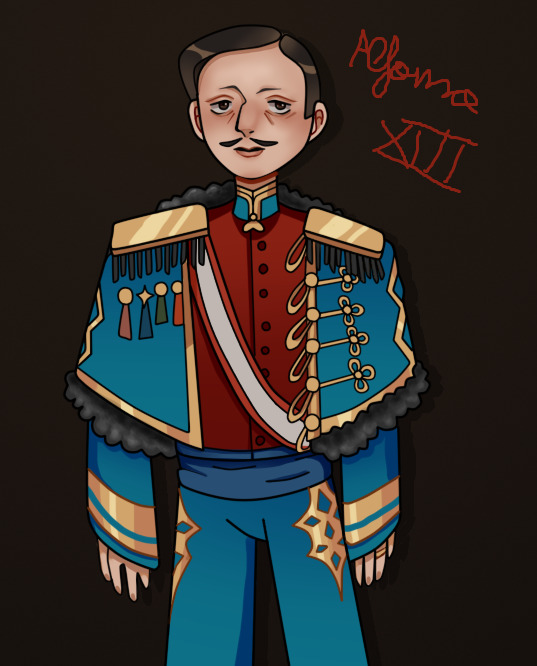
last part
#bourbons#felipev#felipe v#louis i#louis of spain#isabel ii#alfonso xii#alfonso xiii#spain#carlos iii#carlos iv#fernando vi#fernando vii
16 notes
·
View notes
Text
Wprowadzenie
W ciągu dziejów fryzury męskie władców często odzwierciedlały ich władzę i status społeczny. Od wyszukanych peruk po skomplikowane warkocze, fryzury europejskich monarchów w XIV do XIX wieku nie były wyjątkiem. Fryzury te nie tylko były symbolem ich władzy, ale także sposobem na okazanie swojego bogactwa i statusu społecznego. Niektóre z najbardziej charakterystycznych fryzur z tego okresu to proszkowe peruki francuskiego dworu, płynące włosy z ery romantyzmu i schludne fryzury z przedziałkiem z epoki wiktoriańskiej. Przyjrzyjmy się bliżej fascynującym i często ekscentrycznym fryzurami europejskich władców od XIV do XIX wieku.
Einfluss religii i kultury na fryzury męskie
Fryzury męskie w Europie w XIV wieku były zdominowane przez wpływy religijne i kulturowe. Włosy były często układane w proste, mocno przyklejone kaski. W XIV wieku popularne było noszenie długich włosów, które były opuszczane na plecy lub związane w kucyk. Jednakże, w XVI wieku, fryzury męskie zaczęły zmieniać się pod wpływem renesansu i wzorów z antyku. Włosy były układane w skomplikowane upięcia, często z warkoczami, i często ozdabiane perłami lub innymi ozdobami.
W XVII wieku fryzury męskie stały się jeszcze bardziej skomplikowane i wyszukane, a peruki stały się powszechne. W XVIII wieku peruki zaczęły być coraz bardziej popularne, szczególnie we Francji i Anglii. Włosy były często pudrowane, aby uzyskać biały kolor, a peruki były często ozdabiane kwiatami, kokardami lub innymi ozdobami.
W XIX wieku fryzury męskie zaczęły się upraszczać, a peruki zaczęły wychodzić z mody. Mężczyźni zaczęli nosić włosy krótkie lub średniej długości, często z przedziałkiem pośrodku. Fryzury były schludne i proste, a włosy często były przyklejane do głowy przy pomocy specjalnych preparatów.
Fryzury renesansowe
Włosy w epoce renesansu były układane w skomplikowane upięcia, często z warkoczami i ozdobami. Fryzury były inspirowane wzorami z antyku, a mężczyźni zaczęli nosić długie, falujące włosy. Peruki stały się również popularne w epoce renesansu, szczególnie wśród władców i arystokracji.
Włosy były często pudrowane, aby uzyskać biały kolor, a peruki były ozdabiane kokardami, perłami i innymi ozdobami. Fryzury renesansowe były bardzo skomplikowane i wymagały wielu godzin pracy, aby je ułożyć.
Włosy były często układane w kaski lub warkocze, a mężczyźni nosili również peruki. W XVIII wieku peruki stały się coraz bardziej skomplikowane, a pudrowanie włosów stało się popularne.
Fryzury epoki baroku
Fryzury męskie w epoce baroku były bardzo skomplikowane i ozdobione perukami i kwiatami. Włosy były często pudrowane, aby uzyskać biały kolor, i układane w skomplikowane upięcia. Fryzury były często bardzo ciężkie i wymagały specjalnych drutów, aby utrzymać je na głowie.
Włosy były często układane w kaski lub warkocze, a mężczyźni nosili również peruki. W XVIII wieku peruki stały się coraz bardziej skomplikowane, a pudrowanie włosów stało się popularne.
W epoce baroku mężczyźni zaczęli nosić długie, falujące włosy, często związane w kucyk. Peruki stały się również popularne, szczególnie wśród władców i arystokracji. Włosy były pudrowane i często ozdabiane kwiatami, kokardami i innymi ozdobami.
Fryzury epoki rokoka
Fryzury męskie w epoce rokoka były bardzo eleganckie i skomplikowane. Włosy były często pudrowane, aby uzyskać biały kolor, i układane w skomplikowane upięcia. Fryzury były ozdobione perłami, kwiatami i innymi ozdobami.
Włosy były często układane w kaski lub warkocze, a mężczyźni nosili również peruki. W XVIII wieku peruki stały się coraz bardziej skomplikowane, a pudrowanie włosów stało się popularne.
W epoce rokoka mężczyźni zaczęli nosić długie, falujące włosy, często związane w kucyk. Peruki stały się również popularne, szczególnie wśród władców i arystokracji. Włosy były pudrowane i często ozdabiane kwiatami, kokardami i innymi ozdobami.
Fryzury neoklasyczne z końca XVIII wieku
W epoce neoklasycznej mężczyźni zaczęli nosić proste, schludne fryzury. Włosy były często przyklejane do głowy przy pomocy specjalnych preparatów, a przedziałek pośrodku był bardzo popularny. Peruki wychodziły z mody, a pudrowanie włosów stało się coraz rzadsze.
Fryzury męskie w epoce neoklasycznej były bardzo proste i schludne. Włosy były często przyklejane do głowy przy pomocy specjalnych preparatów, a przedziałek pośrodku był bardzo popularny.
W epoce neoklasycznej mężczyźni zaczęli nosić długie, falujące włosy, często związane w kucyk. Peruki stały się również popularne, szczególnie wśród władców i arystokracji. Włosy były pudrowane i często ozdabiane kwiatami, kokardami i innymi ozdobami.
Fryzury romantyczne
W epoce romantycznej mężczyźni zaczęli nosić długie, falujące włosy. Fryzury były proste i naturalne, a peruki wychodziły z mody. Włosy były często przyciemniane, aby uzyskać bardziej naturalny kolor.
W epoce romantycznej mężczyźni zaczęli nosić długie, falujące włosy. Fryzury były proste i naturalne, a peruki wychodziły z mody. Włosy były często przyciemniane, aby uzyskać bardziej naturalny kolor.
Fryzury męskie w epoce romantycznej były bardzo proste i naturalne. Włosy były noszone długie i falujące, często związane w kucyk. Peruki wychodziły z mody, a warkocze były rzadziej używane.
Fryzury wiktoriańskie
W epoce wiktoriańskiej mężczyźni zaczęli nosić proste, schludne fryzury. Włosy były często przyklejane do głowy przy pomocy specjalnych preparatów, a przedziałek pośrodku był bardzo popularny. Fryzury były bardzo eleganckie i schludne, a peruki wychodziły z mody.
Włosy były często noszone krótkie lub średniej długości, a przedziałek pośrodku był bardzo popularny. Fryzury były bardzo schludne i proste, a włosy często były przyklejane do głowy przy pomocy specjalnych preparatów.
Wpływ polityczny i społeczny na fryzury męskie
Fryzury męskie w Europie w XIV do XIX wieku często były narzędziem politycznym i społecznym. Władców i arystokrację często zobowiązywano do noszenia określonych fryzur, aby okazać lojalność wobec króla lub rządu. Fryzury były również sposobem na okazanie swojego statusu społecznego i bogactwa.
W XVIII wieku peruki stały się bardzo popularne, szczególnie we Francji i Anglii. Włosy były często pudrowane, aby uzyskać biały kolor, a peruki były często ozdabiane kwiatami, kokardami lub innymi ozdobami.
W XIX wieku fryzury męskie zaczęły się upraszczać, a peruki zaczęły wychodzić z mody. Mężczyźni zaczęli nosić włosy krótkie lub średniej długości, często z przedziałkiem pośrodku. Fryzury były schludne i proste, a włosy często były przyklejane do głowy przy pomocy specjalnych preparatów.
Dziedzictwo fryzur męskich z XIV do XIX wieku
Fryzury męskie z XIV do XIX wieku pozostawiły wiele śladów w dzisiejszej modzie i kulturze. Niektóre fryzury, takie jak przedziałek pośrodku i proste, schludne fryzury, są wciąż popularne, szczególnie wśród mężczyzn. Mężczyźni nadal noszą długie włosy i warkocze, a peruki są używane w teatrze i filmie.
Fryzury męskie z XIV do XIX wieku były często skomplikowane i wymagały wielu godzin pracy, aby je ułożyć. Włosy były pudrowane i często ozdabiane kwiatami, kokardami i innymi ozdobami. Fryzury te były nie tylko symbolem władzy i statusu społecznego, ale także wyrazem sztuki i kultury.
Podsumowanie
Fryzury męskie europejskich władców z XIV do XIX wieku były nie tylko symbolem władzy i statusu społecznego, ale także wyrazem sztuki i kultury. Włosy były pudrowane, układane w skomplikowane upięcia, a peruki były ozdabiane kwiatami, kokardami i innymi ozdobami. Fryzury te pozostawiły wiele śladów w dzisiejszej modzie i kulturze, i nadal inspirują projektantów i artystów na całym świecie.
#fryzura królów europejskich#KrólPrusCesarzNiemiecWilhelmIIHohenzollernfryzura#Leopoldzie II#królu Belgów fryzurą i brodą#Król Jan III Sobieski - jaką miał fryzurę#Konstytucja 3 Maja#Stanisław August Poniatowski i jego fryzura#Jaką fryzurę miał Władysław Jagiełło podczas bitwy pod Grunwaldem w 1410 roku#Louis Philippe I - Władcza Fryzura i Wybuch Rewolucji Lipcowej#Fryzura Króla Francji Ludwika XIV#Alfonso XII - Twórca pokoju i mężczyzna ze stylowymi bokobrodami
1 note
·
View note
Text
Fuegoen el Misisipi 1781: Estados Unidos necesita a España pra lograr su independencia
Fuegoen el Misisipi 1781: Estados Unidos necesita a España pra lograr su independencia
Versión Kindle
Alfonso de Salazar llega a Nueva Orleans en 1764. Su juventud y vitalidad harán que muy pronto sea contratado como confidente del gobierno español en la Luisiana, cuya capital, Nueva Orleans, bulle inquieta ante la rebelión de las vecinas colonias británicas, aguardando expectante cuál será la actitud que el Rey Carlos III tome ante tan grave situación.La misión de Salazar…

View On WordPress
#Alfonso de Salazar#Bernardo de Gálvez#Carlos III de España#ESTADOS UNIDOS NECESITA A ESPAÑA PARA LOGRAR SU INDEPENDENCIA#FUEGO EN EL MISISIPI#Nueva Orleans#Pérez-Foncea#Pensacola
0 notes
Text
Gallery Collection 001

Published: 2-21-2024 | Updated: N/A
SUMMARY
This is the first in a series of upcoming investment objects for Sims 2 – things your sims can use to generate income over time. From 1975-2000, Anheuser-Busch, Inc. commissioned 30 paintings of African kings and queens for an extended outreach and marketing campaign. This set of paintings features artwork from this amazing series. Celebrate Black History Month 2024! #co2bhm #bhm2024 #sims2bhm.
*No copyright infringement intended – I own no rights to these images.
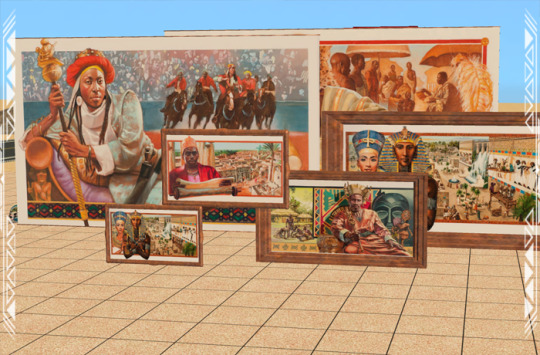

DETAILS
Requires Sims 2. Requires Apartment Life for shiftability.
§1K-15K | Buy > Deco > Wall Hangings
Paintings are centered on 1-tile but cover more tiles than that. They come in various gallery sizes and images have been edited to fit the mesh. After purchase, their value increases by approximately 2% daily – watch out for burglars!
Files with “MESH” in their name are REQUIRED. Frame recolors include EA/Maxis and yeti textures. Frame and painting recolors are merged into two files so you’ll have to take them or leave them.
ITEMS
Great Kings & Queens of Africa: Paintings 001-006 (92-764 poly)
DOWNLOAD (choose one)
from SFS | from MEGA
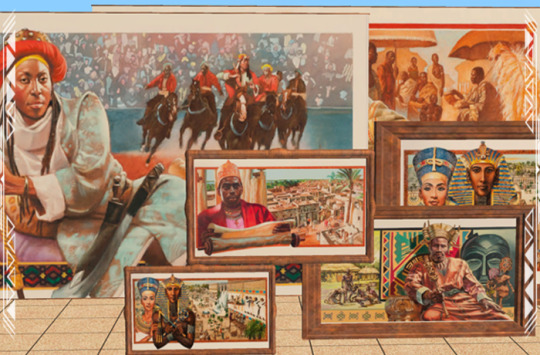

IMAGES
Akhenaton Pharaoh of Egypt (1375-1358 BC) by Barbara Higgins Bond
Alfonso I King of the Kongo (circa 1486-1543) by Carl Owens (1929-2002)
Askia Muhammaed Toure King of Songhay (1493-1529) by Leo Dillon
Benhanzin Hossu Bowelle—The King Shark (1841-1906) by Thomas Blackshear II
Cleopatra VII Queen of Egypt (69-30 BC) by Ann Marshall
Hannibal Ruler of Carthage (247-183 BC) by Charles Lilly
Hatshepsut The Ablest Queen of Far Antiquity (1503-1482 BC) by Dean Mitchell
Idris Alooma Sultan of Bornu (1580-1617) by Charles Lilly (1949-)
Ja Ja King of the Opobo (1821-1891) by Jonathan Knight
Khama III The Good King of Bechuanaland (1819-1923) by Carl Owens
Makeda Queen of Sheba (960 BC) by Debra Edgerton
Mansa Kankan Musa King of Mali (1306-1337) by Barbara Higgins Bond
Menelek II King of Kings of Abyssinia (1844-1913) by Dow Miller
Moshoeshoe King of Batsutoland (circa 1786-1870) by Jerry Pinkney
Mwana Ngana Ndumba Tembo—Ruler of the Angolan Tchokwe (1840-1880 circa) by Kenneth Calvert
Nandi Queen of Zululand (1778-1826 AD) by HM Rahsaan Fort II
Nefertari Nubian Queen of Egypt (192-1225 BC) by Steve Clay
Nehanda of Zimbabwe (1862-1898) by Lydia Thompson
Nzingha—Amazon Queen of Matambo (1582-1663) by Dorothy Carter
Osei Tutu King of Asante (circa 1650-1717) by Alfred Smith
Queen Amina of Zaria (1588-1589) by Floyd Cooper
Samory Toure The Black Napoleon of the Sudan (1830-1900) by Ezra Tucker
Shaka-King of the Zulus (1787-1828) by Paul Collins
Shamba Bolongongo African King of Peace (1600-1620) by Roy LaGrone
Sunni Ali Beer King of Songhay (circa 1442-1492) by Leo Dillon
Taharqa King of Nubia (710-664 BC) by John Thomas Biggers
Tenkamenin King of Ghana (1037-1075 AD) by Alexander Bostic
Thutmose III Pharaoh of Egypt (753-712 BC) by Antonio Wade
Tiye The Nubian Queen of Egypt (circa 1415-1340 BC) by Leonard Jenkins
Yaa Asantewa Queen of Ghana (1863-1923) by Barbara Higgins Bond
CREDITS
No copyright infringement intended – I own no rights to these images. Artwork and trademarks are the property of their respective creators and/or owners. If this exceeds fair use, please contact me via private message.
Thanks: Simming and Sketchfab Communities. Sources: Any Color You Like (CuriousB, 2010), Beyno (Korn via BBFonts), Console Certificates (d_dgjdhh, 2019; 2011), EA/Maxis, Gyeongbokgung Sajeongjeon Painting (National Heritage Administration, 2024 via CCA; Sketchfab), Great Kings and Queens of Africa Series (Anheuser-Busch, Inc., 1975-2000; Kentake, 2016), Offuturistic Infographic (Freepik), Painting by Zdzislaw Beksinski (Sosnowski, 2018 via CCA), Yeti Metals (Shastakiss, 2017).
76 notes
·
View notes
Photo

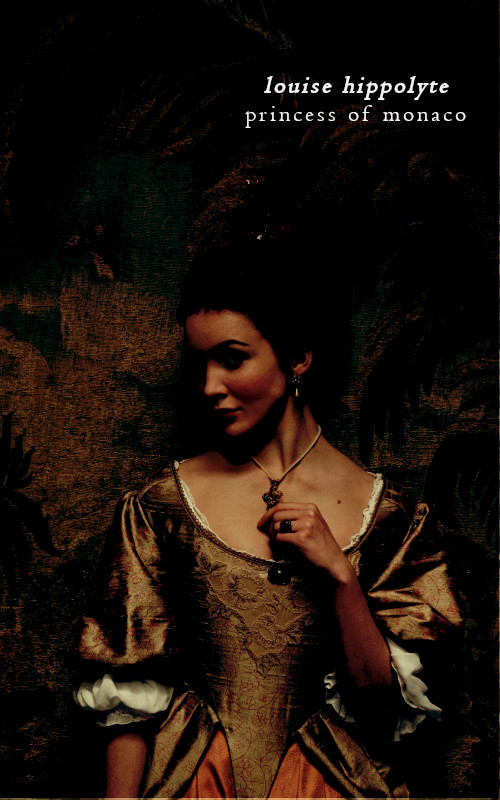
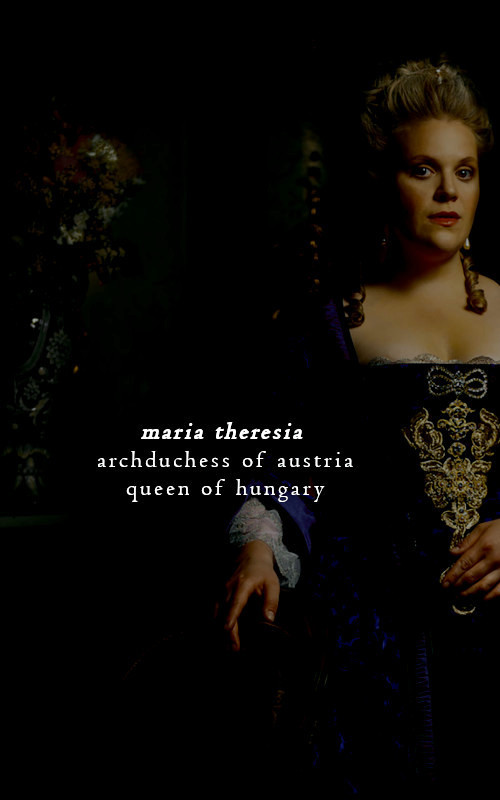
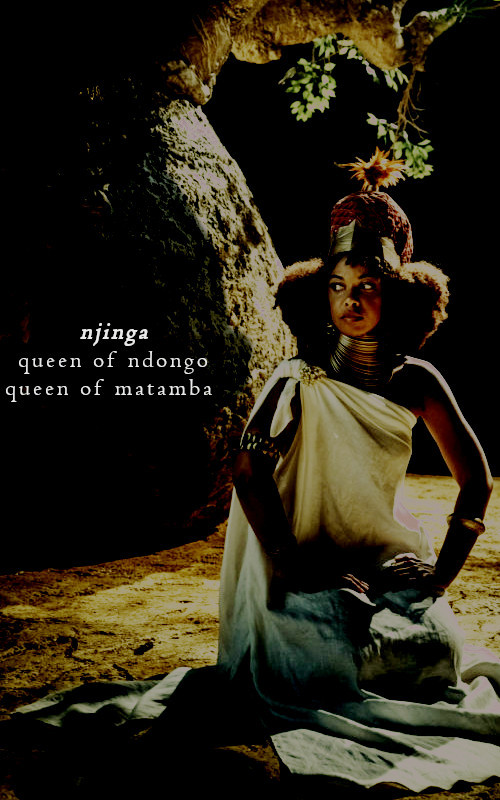
Favorite list of royal women | Regnant queens (who crowed herself queen without her husbands)
Been a queen regnant is not always easy specially when you are married but mor common than one would think. Here four of my favorite queen that were married and despite what society, and often the husband himself, thought decided that her lands by heritage or conquest were only hers to rule.
i. [1081-1116] Called The Reckless, Urraca was one of the most powerful reigning Queens of her time having inherithed the kingdom of León. Upon the death of her first husband she was convinced to marry Alfonso of Aragon the most successful warrior king of the Iberian Peninsula. It went horribly wrong. Personalities clashed and Alfonso emprisoned Urraca at one point. With Galicia rebelling and the Almoravides menace the spouses still went to war againts each other. Finally they separate and while Urraca still has a long way ahead and could keep most of her lands for herself.
ii. [1697-1731] Louise Hyppolite was at her time of birth the last Grimaldi. Monaco was under French control and it was decided that man from the French King family will be Louise’s husband and rule along with her. She was married and had to leave her land with her husband. Described as shy and submissive she did not enjoy her time at Versailles. When her father was ill she came back alone to Monaco and when he died she crowned herself Princess of Monaco with the people enthusiastic support naming her firstborn heir. There is no much her husband could do and though she ruled fr a short time she did it as the sole Princess.
iii. [1717-1780] Maria Theresia’s father Emperor Charles VI of the Roman Empire, did not prepared her to rule as he was convinced that her husband would rule for her. However, she had other plans and when her father died Maria Theresa, a 23 years old set to stablish her right as a moanrch against Prussia and most of Europe. She manage to gain ruling experience and be a monarch for 40 years. Though she deeply loved her husband she did not let him rule in her name and even refused to kneel in front of him when he was elected Holy Roman Emperor as she was of highest ruler. She was Sovereign of Hungary and Bohemia and Archduchess of Austria on her own right her husband being the consort.
iv. [1583-1663] Njinga was Queen of Ndongo after her father and brother. At the time with the Portuguese slave trade Njinga became a symbol of resistance to the Europeans. In order to gain power in the center of the region she married an Imbangala leader and learned the techniques and strategies of his people. However when she set to conquer the kingdom of Matamba and ruled there as the Queen as Matamba had tradition of female rulers. As she gained influence she was recognized as one of the great queens of the region at the time.
#historical women#women in history#maria theresia#njinga of ndongo and matamba#urraca of leon#louise hyppolite of monaco#maria theresa of austria#history
133 notes
·
View notes
Text



















Historical Portraits of Children // The Truth is a Cave – The Oh Hellos
Four Children Making Music – attributed to the master of the Countess of Warwick, 1565 // Three Children with a Dog or Two Sisters and a Brother of the Artist – Sofonisba Anguissola, 1570-1590 // The Children of Philip III of Spain (Ferdinand, Alfonso, and Margarita) – Bartolomé González y Serrano, 1612 // Three Children with a Goat-Cart – Frans Hals, 1620 // The Balbi Children – Anthony van Dyck, 1625-1627 // The Three Eldest Children of Charles I – Anthony van Dyck, 1635-1636 // Five Eldest Children of Charles I – Anthony van Dyck, 1637 // Portrait of the Children of Habert de Montmor – Philippe de Champaigne, 1649 // Group Portrait of Charlotte Eleonora zu Dohna, Amalia Louisa zu Dohna, and Friedrich Christoph zu Dohna-Carwinden – Pieter Nason, 1667 // The Graham Children – William Hogarth, 1742 // Portrait of Sir Edward Walpole’s Children – Stephen Slaughter, 1747 // The Bateson Children – Strickland Lowry, 1762 // The Gower Family: The Five Youngest Children of the 2nd Earl Gower – George Romney, 1776-1777 // Marie-Antoinette de Lorraine-Habsbourg, Queen of France, and Her Children – Élisabeth Louise Vigée Le Brun, 1787 // The Marsham Children – Thomas Gainsborough, 1787 // The Oddie Children – William Beechey, 1789 // Three Siblings – Johann Nepomuk Mayer, 1846 // Happy Children – Paul Barthel, 1898 // My Children – Joaquín Sorolla, 1904 // The Truth is a Cave – The Oh Hellos
#this line makes me feel Very Normal and not at all Deranged 🥴😵💫#portraiture#family portrait#portrait#portrait painting#sofonisba anguissola#frans hals#anthony van dyck#philippe de champaigne#william hogarth#george romney#elisabeth vigee le brun#elisabeth louise vigee le brun#thomas gainsborough#joaquin sorolla#the truth is a cave#the truth is a cave song#the truth is a cave the oh hellos#through the deep dark valley#through the deep dark valley album#through the deep dark valley the oh hellos#the oh hellos#art history#art#lyrics#lyric art#long post
33 notes
·
View notes
Note
How does Alfonso feel about Coral (though he has already passed)
Did not like her but in a more passive way compared to how Elizabeth felt (REALLY didn’t like her to point of hating her). He felt she was a snob and he didn’t care for her father either but he knew Dylan liked her a lot plus she was from the ten family so he saw no point in fighting against them.
#ask#answer#cards#spades#Alfonso espadas iii#king of spades#coral Morphew#coral morphew-espadas#ten of spades#Dylan espadas#Jack of spades#gen 1#Elizabeth solorio#Elizabeth solorio-espadas#queen of spades
17 notes
·
View notes
Text

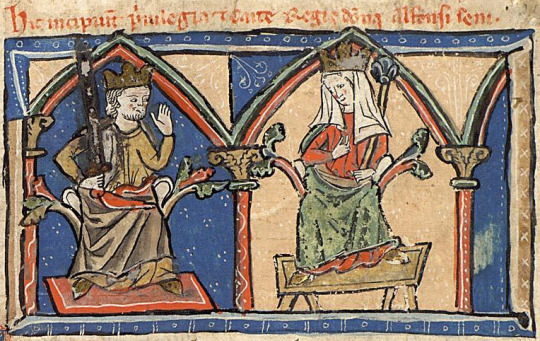




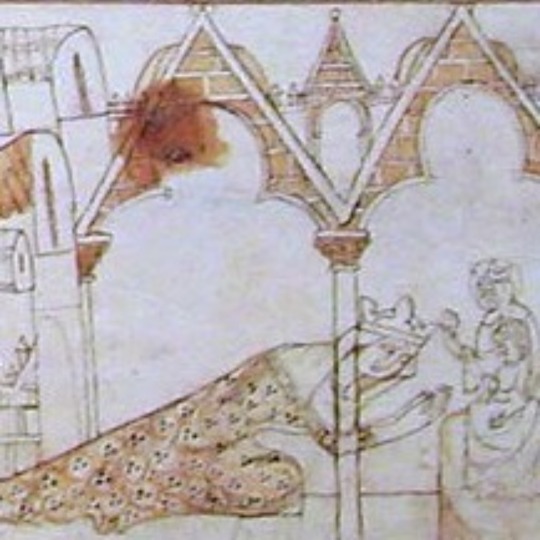

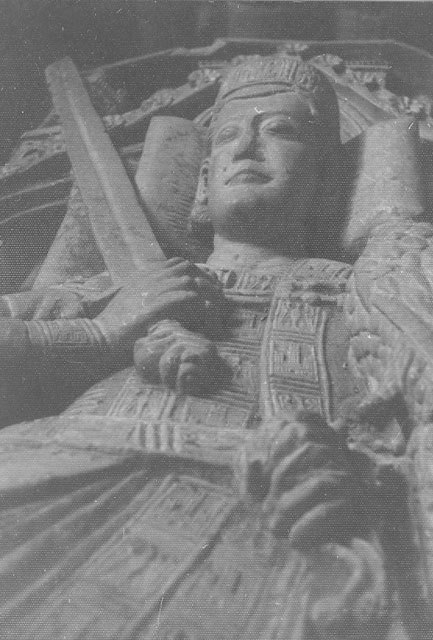

The Bastard Kings and their families
This is series of posts are complementary to this historical parallels post from the JON SNOW FORTNIGHT EVENT, and it's purpouse to discover the lives of medieval bastard kings, and the following posts are meant to collect portraits of those kings and their close relatives.
In many cases it's difficult to find contemporary art of their period, so some of the portrayals are subsequent.
1) Ferdinand III of Castile (1199/1201 – 1252), son of Alfonso IX of Leon and his wife Berenguela I of Castile
2) Alfonso IX of Leon (1171 – 1230), son of Ferdinand II of Leon and his wife Urraca of Portugal; with Berenguela I of Castile (1179/ 1180 – 1246), daughter of Alfonso VIII of Castile and his wife Eleanor of England
3) Blanche of Castile (1188 – 1252), daughter of Alfonso VIII of Castile and his wife Eleanor of England
4) Henry I of Castile (1204– 6 June 1217), son of Alfonso VIII of Castile and his wife Eleanor of England
5) Urraca of Castile (1186/ 1187 – 1220), daughter of Alfonso VIII of Castile and his wife Eleanor of England
6) Ferdinand of Leon (ca. 1192 – 1214), son of Alfonso IX of Leon and his wife Theresa of Portugal
7) Elisabeth of Swabia (1205 – 1235), daughter of Philip of Swabia and Irene Angelina
8) Alfonso X of Castile (1221 – 1284), son of Ferdinand III of Castile and his wife Elisabeth of Swabia
9) Philip of Castile (1231- 1274), son of Ferdinand III of Castile and his wife Elisabeth of Swabia
10) Eleanor of Castile (1241- 1290) daughter of Ferdinand III of Castile and his wife Joan of Ponthieu: with Edward I of England ( 1239 – 1307), son of Henry III of England and his wife Eleanor of Provence
Note: The marriage of Alfonso IX's parents got also annulled/declared void due to consanguinity, but I didn't include him on the list because this example is already present in Ferdinand III & IV
#jonsnowfortnightevent2023#canonjonsnow#asoiaf#a song of ice and fire#day 10#echoes of the past#historical parallels#medival bastard kings#bastard kings and their families#ferdinand iii of castile#alfonso ix of leon#berenguela i of castile#blanche of castile#henry i of castile#ferdinand of leon#urraca of castile#alfonso x of castile#philip of castile#eleanor of castile#edward i of england
4 notes
·
View notes
Text
Sala del Almirante de los Reales Alcázares de Sevilla: el cuadro de "Las postrimerías de San Fernando" de Virgilio Mattoni
Vista general de la Sala del Almirante.
Inicio el examen de este importantísimo edificio de Sevilla con esta Sala, cuya importancia histórica es innegable:
Debe su nombre al Tribunal del Almirantazgo de Castilla, que tuvo su sede aquí. El Salón del Almirante era una parte de la “Casa de Contratación de las Indias”, institución funda- da en el Alcázar de Sevilla en 1504 por Isabel la Católica…
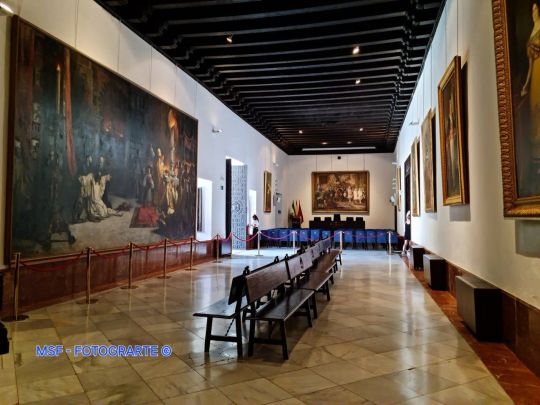
View On WordPress
#Alfonso X el Sabio#Crónicas de España (Alfonso X el Sabio)#Edad Media#En Español#España#Fernando III el Santo#Pintura#Pintura histórica#Pintura religiosa#Reales Alcázares de Sevilla#Sala del Almirante#Sevilla#Siglo XIX#19th century#Middle Ages#Ferdinand III the Saint of Castille#Alphonse X the Wise of Castille#Castille#Spain#Seville#Paintings#19th century paintings#13th century
2 notes
·
View notes
Text
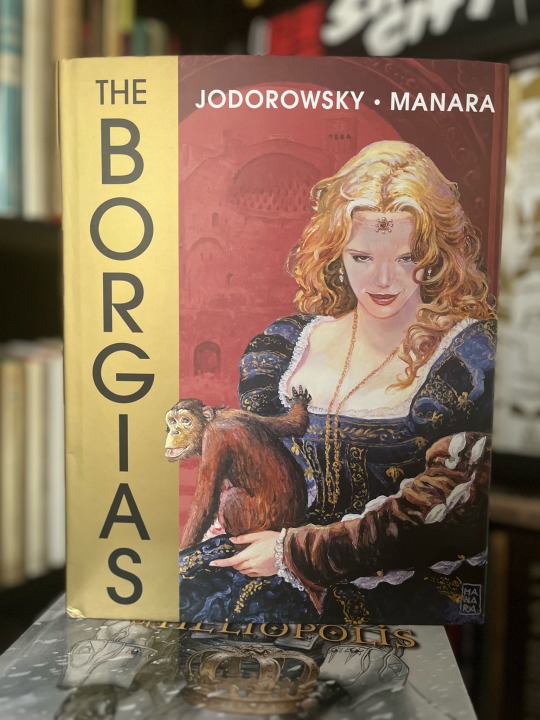
“THE BORGIAS AND THE MAFIA
In 1455, the Holy See was occupied by Alfonso de Borja, a descendant of this eighth knight, under the name Callixtus III. Having gained the trust of King Alfonso Il of Naples, he came to power at the age of seventy-seven, while suffering from stomach cancer. His pain made him suspicious. He believed only in the loyalty of his Spanish family. Through the legacy of inheritance, his fortune fell into the hands of Rodrigo Borgia, who used it to fund his own ascension to the papal throne. Thus was born the first Mafia clan in history.
The Borgias possessed an absolute thirst for power. Europe had, by then, lost all hope in the goodness of God: the plague known as the Black Death had made miserably clear just how precarious human life can be, and with the bitterness of an orphan deprived of its supreme father, the populace consoled itself by indulging in carnal pleasures. It was in this context that Rodrigo Borgia, now Pope Alexander VI, began trafficking in a very powerful drug: papal bulls, which granted the forgiveness of sins . . . Every citizen could murder, steal, gamble, engage in prostitution or incest or unbridled gluttony, and all without fear: because in exchange for a handful of ducats, the Church offered absolution and the assurance that God would welcome the sinner into heaven.
The Borgias' passion for life, for dominance over all mankind, their disdain of any divine retribution, this absolute lack of morality, offset by their staggering appreciation of fine art, utterly captivated me. Knowing that the respectable Church of today once had a Spanish adventurer at its roots, a clever thief who was surrounded by his bought-and-sold lovers and by his children, each embodying a spiritual summit as well as an abyss - Cesare, strength and tyranny; Lucrezia, beauty and lust; Giovanni, intelligence and vanity; Gioffre, purity and stupidity - reminded me of the lotus plant, whose bright flowers spring from filthy swamps . . . And so I yielded to the temptation to write a comics script: in the form of a vast historical fresco on the creation, growth, and death of this provocative family, so similar to some of the people currently governing our planet.
(…)
In place of the Black Death, we have cancer and AIDS, along with pollution of our air, our water, and our planet. Instead of cities at war, we are witness to entire countries fighting. Christianity and Islam remain in conflict even today. The discovery of the Americas has now become interplanetary exploration. We're experiencing the artistic revolution of the Renaissance through personal computers and the Internet. The papal bulls of yore are today's commercial "benedictions" from the United States. Just as the ducat was the key to paradise during the Renaissance years, our only God is the almighty dollar: whether its value goes up or down and the gates of heaven open or close . . . Just as Machiavelli, in his book The Prince, recommended aggressive invasions to achieve Italian unity, in this day and age a powerful nation (that shall remain nameless) ruthlessly attacks any country, claiming to obstruct "Evil" but spurred on, in fact, by its thirst for oil . . . Today, the Borgias have been replaced by oil mafias, pharmaceutical industry multinationals, drug cartels, and greedy bankers.
And yet, the corruption that flourished during the Renaissance could not prevent the emergence of a Leonardo da Vinci, a Raphael, a Botticelli, a Michelangelo, a Dante, a Machiavelli even, as well as so many others who opened up new vistas to human awareness. This is what brings us great hope: the possibility that the decadence of the world today is just the pain of a chrysalis becoming a butterfly, and that from the last vast crisis into which we plummet a new humanity will arise, one that will look upon us with the same tender compassion we feel for the monkeys.
—Alejandro Jodorowsky
August 2011”
#jodorowsky#alejandro jodorowsky#manara#milo manara#borgia#borgias#graphic novel#comic books#dark horse#papacy#pope#Italy#renaissance#machiavelli
99 notes
·
View notes
Text

Drawing of Henry VI of England by Jörg von Ehingen.
From 1457-1459, Swabian knight Jörg von Ehingen traveled Europe participating in various campaigns; throughout, he kept a journal and sketchbook of his impressions of the many royal courts he passed through. His compilation includes portraits, in the order of his visits, of Duke Ladislaus V of Austria, Charles VII of France, Henry IV of Castile, Henry VI of England, Alfonso V of Portugal, Janus III of Cyprus, Duke René of Anjou, John II of Aragon, and James II of Scotland.
#we love a contemporaneous portrait from an eyewitness#absolutely dapper hat#you may be familiar with Alfonso V's incredible poulaine shoes and/or his terrible heraldic lion#Henry's got pretty swell poulaines himself#altho I have just noticed his lil skelly hands#plantagenets#manuscript
62 notes
·
View notes